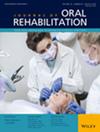Influence of Liquid Viscosity on Swallowing Dynamics in Healthy Adults: A Study Using a New Noninvasive Laryngeal Motion Evaluation Instrument
Abstract
Background
A noninvasive laryngeal motion evaluation device using photoelectric distance sensors (Nodomiru) has been newly developed and reported to be useful in evaluating swallowing dynamics. This device can easily obtain a laryngeal movement velocity curve and a laryngeal movement position curve. In this study, we aimed to examine how liquid viscosity affects the swallowing dynamics after verifying the usefulness of data smoothing in this measurement.
Methods
This study included 33 healthy adults (mean age: 28.8 ± 9.7 years). They were instructed to swallow saliva and 3 mL of thin and medium-thickened liquids three times each in a sitting position. Laryngeal movements during these trials were evaluated using Nodomiru. The comma-separated value data output, which included laryngeal position and time information obtained from Nodomiru, were used to calculate the following parameters: laryngeal elevation time, elevation distance, velocity and laryngeal elevation persistence time with and without smoothing.
Results
The intraclass correlation coefficient values of elevation peak velocity for the three swallowing trials of liquids were higher with smoothing (0.77) than without smoothing (0.54). Elevation peak velocities were 128.9 ± 56.8, 149.8 ± 47.2, and 173.5 ± 62.7 mm/s for saliva, thin liquid (water), and moderately thick liquid, respectively, demonstrating significant differences.
Conclusions
Using a smoothing procedure is beneficial for analysing the swallowing dynamics with Nodomiru. Furthermore, increasing liquid thickness promoted increased laryngeal movement velocity in healthy adults.


 求助内容:
求助内容: 应助结果提醒方式:
应助结果提醒方式:


